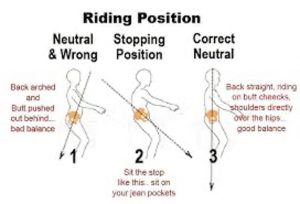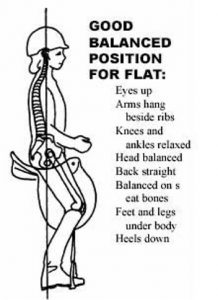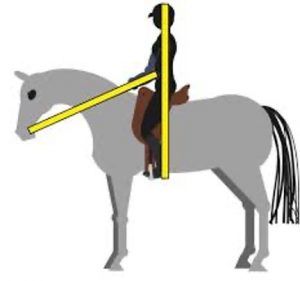Lesson Material
“Every ride is a training session – a chance to improve the communication and trust between horse and rider”
In our training of a horse, we want to improve the horses usefulness: to make them a joy to ride and work with.
Schooling – When we school a horse we have a program of progressive physical and mental exercises for the horse and rider designed to improve the horses obedience to the rider and the riders communication with the horse.
Conformation – A riding horse must be sound. A horses feet and legs are very important for its overall performance and wellbeing. The hoof shape or outline on the ground should be round at the front and oval in the rear or back feet. The wall should be thick, strong and smooth or straight grained. They should be proportionate to its size and weight slightly bigger in front as the front end carries about 75% of the weight. The sole should be concave, the heels well separated by the frog which should be near to the ground large and tough. The horse has very deep big muscles in its shoulder but not much in its legs. The heart has to work hard to pump blood to the horses hooves and to help the heart work, the frog works as a pump helping move blood back up the leg to the heart. Forefeet should point to the front, hind may turn out slightly. The angle of the hoof to ground should match the angle above the hoof to the fetlock joint above or the pastern. The pastern should be free from any bony growth such as ring bone.
Points of the horse & correct conformation
Cannon bone – short compared with forearm
Should – flat and long, nice slope so that legs are out in front
Hock – large and strong
Standing straight when viewed from behind
Stifle joint – strong and prominent at the same height as the elbow
Gaskin or second thigh – thick well set longer than hock to fetlock.
Croup – long wide and muscular
Head – proportionate, forehead broad, eyes clear kind and intelligent set well apart,
Neck – strong with a slight arch
Withers – high and long to mouth – length of rein
Back and loin – short wide and strong
Breast – strong and thick but not too wide
Dock – strong for balance
Talking the same language – Pressure and release
Your role as leader and teacher with respect being earned. Understand what motivates the horse rather than thinking about what you want. Human assumptions can be quite wrong and dangerous. We must show him the rules of behavior when with us.
Pressure for a horse is another horse too close or fear of isolation when a horse is under pressure he will adjust the situation to be more comfortable and free of the pressure. This makes a horse relatively easy to train. If we apply this consistently. Horses like to know what is wanted of them – the black and white rather than grey. Consistency is the key to making your relationship work.
Reward the try and build on it. Learn to recognize the try. Do not expect perfection and then correct everything else that’s wrong.
Timing and feel: the timing of the reward is everything. Release the pressure once the horse has performed correctly. This takes feel – or knowing what the horse is thinking.
Position and Balance
The correct riding position will help you to be in balance on the horse so that you can give the correct aids for control. This will help the horse with its balance.
The correct riding position has straight lines through the points
- Shoulder, hip, heel
- bit, hand elbow
- down the spine
Halt
One of the most important skills for any rider to master is how to slow down and how to stop carefully.
The way to slow a horse down correctly is to no longer follow the movement of the horse but to brace your back and sit deep in the saddle, weight in heals and restrain with reins or if necessary, pull the reins towards your body and close the hands.
Stopping, or halting, is done in a broadly similar way to slowing down. You need to close the hands on the reins or pull the reins gently but firmly until the horse has come to a complete stop.
If the horse does not stop when asked, do not continue to pull the reins. Relax your body and then start the whole thing again.
Once he has stopped, relax, release slightly and reward with a rub.
Move forward
The aids which may be used to obtain control on the horse are the legs, seat, voice and reins and artificial aids include the whip, crop and spurs.
All horses are different: To move forward some horses will require a gentle closing of the legs just behind the girth and a following motion adopted by the seat rather than a restraining action. The reins are no longer used to restrain, but relaxed slightly. Other more stubborn ponies or less educated horses may require this aid in combination with the voice aid (a click or “walk on” command) and slight pressure to move in one direction or another by an opening of the rein in the direction of travel and stronger leg aids even a kick.
Turning
To change direction to the left, the left leg is placed on the girth and the right behind as a holding or guiding leg. There is a slight increase in weight on the inside seat bone. The inside rein in closed and squeezed and the eyes and head are looking in the direction of the movement. To turn right reverse.
Lesson Flat work in the dressage arena
The arena – enter at A, halt, change diagonals, serpentine
|
How do you use your Aids and for what ?
Seat
Legs or calf muscles
Hands and elbows
Voice
Crop or whip
Body position – hip, eyes, head
Draw a serpentine and a figure 8 in the arena above.
What do you notice about the circles in the arena? And how they meet? What might help you to ride a circle or figure 8?
Introductory lesson at Hills and Hollows – The A.B.C:
A: Always be careful – Know the hazards & dangers
B: Balance – The seat, legs, hands and eyes – practice muscle use and gravity (gym ball) & horse Tai Chi
C: Communicate & Control – Understanding horses in the wild helps us to communicate better for control. You are always training your horse for better or worse.
Practice Mounting & Dismounting, Halt, moving forward, turning. Remember – Be as soft as you can and as hard as you need
Balance:
3 straight lines – Seat plus hands – hands are carried, closed and communicating. 


